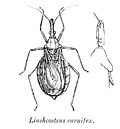 | The members of the Triatominae /traɪ.əˈtɒmɪniː/, a subfamily of the Reduviidae, are also known as conenose bugs, kissing bugs (so-called from their habit... 19 KB (2,279 words) - 15:33, 12 March 2024 |
 | of assassin bug in the subfamily Triatominae (kissing bugs). The members of Triatoma (like all members of Triatominae) are blood-sucking insects that can... 9 KB (755 words) - 13:36, 6 December 2023 |
allows a triatominae, a vector of the flagellate, to take a blood meal from the patient. The doctor later inspects the gut of the triatominae for growth... 2 KB (220 words) - 22:25, 28 April 2023 |
 | family Pentatomidae. In Chile, it has been confused with kissing bugs (Triatominae), causing unjustified alarm. The average length is 16–20 millimetres... 13 KB (1,438 words) - 03:20, 1 May 2024 |
 | subcomplex (Hemiptera: Reduviidae: Triatominae). Acta Tropica. 212: 1-10. Mello, D. A. (1976). Biology of Triatominae (Reduviidae Hemiptera) from North... 11 KB (1,375 words) - 17:22, 9 March 2024 |
 | Poinar, G. (2005). "Triatoma dominicana sp. n. (Hemiptera: Reduviidae: Triatominae), and Trypanosoma antiquus sp. n. (Stercoraria: Trypanosomatidae), the... 64 KB (6,449 words) - 08:37, 4 May 2024 |
 | Rhodnius is a genus of assassin bugs in the subfamily Triatominae (the kissing bugs), and is an important vector in the spread of Chagas disease. The... 5 KB (400 words) - 13:36, 6 December 2023 |
 | (2002). "Triatoma rubrovaria (Blanchard, 1843) (Hemiptera, Reduviidae, Triatominae) II: Trophic resources and ecological observations of five populations... 12 KB (1,290 words) - 03:55, 8 April 2024 |
Head louse Siphonaptera (fleas) Tabanidae (horse flies) Tantulocarida Triatominae Pea crab Sacculina Hirudinea (some leeches) Monogeneans are flatworms... 4 KB (297 words) - 08:36, 4 May 2024 |
Microtriatoma is a genus of bugs that belongs to the subfamily Triatominae. This genus has two known species: M. borbai (Lent & Wygodzinsky, 1979 (Tc))... 1 KB (103 words) - 20:23, 24 September 2023 |
(Hemiptera, Triatominae) en el estado brasileño de "Rio Grande do Sul"" [Finding of Triatoma platensis Neiva, 1913 (Hemiptera, Triatominae) in the Brazilian... 2 KB (181 words) - 05:40, 22 January 2024 |
is a hematophagous insect, a Chagas disease vector, included in the Triatominae group. It occurs in the north of Minas Gerais state, Brazil, and is found... 2 KB (184 words) - 13:56, 6 December 2023 |
 | Triatominae (the kissing bugs). It is the only genus of Triatomines restricted to the Old World within the mostly Neotropical subfamily Triatominae (a... 6 KB (674 words) - 08:53, 13 August 2023 |
Alberproseniini Martínez & Carcavallo, 1977 belongs to the subfamily Triatominae and only has one genus, Alberprosenia Martínez & Carcavallo, 1977, with... 1 KB (94 words) - 19:41, 15 January 2023 |
The genus Psammolestes belongs to the subfamily Triatominae. It can be found in the nests of various birds, mainly in the family Furnariidae. 3 species:... 1 KB (107 words) - 05:03, 5 February 2024 |
 | 2005). "Triatoma rubrovaria (Blanchard, 1843) (Hemiptera - Reduviidae - Triatominae) IV: bionomic aspects on the vector capacity of nymphs". Memórias do... 4 KB (503 words) - 07:35, 15 January 2024 |
 | A., et al. (2012). The biology of three Mexican-American species of Triatominae (Hemiptera: Reduviidae): Triatoma recurva, Triatoma protracta and Triatoma... 3 KB (304 words) - 08:04, 26 May 2023 |
 | stinging or biting insects such as Hymenoptera (ants, bees, and wasps) or Triatominae (kissing bugs) may cause anaphylaxis in susceptible people. Previous... 58 KB (6,188 words) - 17:25, 6 May 2024 |
disease (American trypanosomiasis) Various assassin bugs of subfamily Triatominae Trypanosoma cruzi (protozoan) Mild symptoms, then chronic heart or brain... 7 KB (283 words) - 23:18, 11 December 2023 |
 | by Trypanosoma cruzi. It is spread mostly by insects in the subfamily Triatominae, known as "kissing bugs". The symptoms change over the course of the... 67 KB (7,183 words) - 04:03, 27 April 2024 |
 | scratches from infected cats Chagas disease Trypanosoma cruzi armadillos, Triatominae (kissing bug) Contact of mucosae or wounds with feces of kissing bugs... 78 KB (6,676 words) - 21:48, 1 May 2024 |








